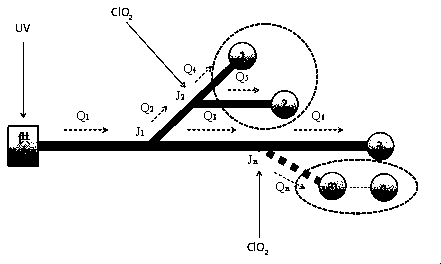Disinfection method of recycled water
A disinfection method and reclaimed water technology, applied in the direction of light water/sewage treatment, sterilization/microdynamic water/sewage treatment, etc., can solve the problem that ultraviolet disinfection technology cannot provide continuous disinfection ability, chlorine dioxide is easy to explode, and disinfection costs increase, etc. problems, to achieve the effect of inhibiting photoreactivation, improving bactericidal ability, and enhancing disinfection ability
- Summary
- Abstract
- Description
- Claims
- Application Information
AI Technical Summary
Problems solved by technology
Method used
Image
Examples
Embodiment 1
[0038] Embodiment 1: Ultraviolet radiation dose test.
[0039] The irradiation intensity of the test is 7.76, 13.18, 17.03, 22.28, 28.5mw / cm 2 , the UV dose is 8, 16, 24, 32, 40, 48, 56, 64, 90mJ / cm 2 The disinfection effect of ultraviolet rays on the number of fecal coliforms and the total number of bacteria in water was tested under certain conditions.
[0040] The test water quality is as follows:
[0041]
[0042] The removal rate of ultraviolet rays on the number of fecal coliforms is as follows: figure 2 As shown, the inactivation rate of ultraviolet rays to fecal coliform bacteria in water increases with the increase of ultraviolet dose. When reaching the maximum value of 4.67log, the inactivation rate exceeds 99.99%, almost all the fecal coliform bacteria in the water body are killed, and the level of fecal coliform bacteria in the disinfected water is low.
[0043] When the irradiation dose is the same, the higher the intensity of ultraviolet irradiation, the ...
Embodiment 2
[0047] Embodiment 2: Chlorine dioxide dosing reaction time test.
[0048] The test uses the static beaker experiment to study the reaction time. Take 6 250ml beakers, pour 200ml water samples into the test, and number the beakers accordingly, and add 2, 3, 4 mg / L to the 5 beakers in turn. Add a certain amount of stable chlorine dioxide disinfection solution, and place it under the mixer to stir at a constant speed. During the test, the decontaminated water samples were tested for the number of fecal coliform bacteria when the reaction time was 2, 5, 10, 15, 20, 25, 30, and 35 minutes respectively.
[0049] The test water quality is as follows:
[0050]
[0051] Sufficiently long reaction time can ensure that the reaction of chlorine dioxide to kill living microorganisms is more thorough. When the concentration of chlorine dioxide is high, the inactivation effect can be achieved in a short period of time; low-concentration chlorine dioxide disinfection can also be achieved ...
Embodiment 3
[0055] Embodiment 3: Chlorine dioxide dosage test.
[0056] The test uses a static beaker test to study the disinfection effect of chlorine dioxide. Use a sterilized 250ml beaker to take several cups of test water samples of 100ml, and the dosage of chlorine dioxide is 1, 2, 3, 4, 5, 6, and 7mg respectively. / L, and the reaction time was 30 minutes, and the bactericidal effect of chlorine dioxide was studied. After 15 minutes, each water sample was taken immediately for microbial index detection.
[0057] Test water quality is the same as embodiment 2, and dosage is to the bactericidal effect of microorganism in water sample as follows: Figure 5 As shown, under the condition of constant reaction time, the inactivation rate of chlorine dioxide on the total number of bacteria and fecal coliform bacteria increases with the increase of the dosage of disinfectant. When the dosage continues to increase, the inactivation rate tends to be Stablize.
[0058] When the dosage is 3mg / L...
PUM
 Login to View More
Login to View More Abstract
Description
Claims
Application Information
 Login to View More
Login to View More - R&D
- Intellectual Property
- Life Sciences
- Materials
- Tech Scout
- Unparalleled Data Quality
- Higher Quality Content
- 60% Fewer Hallucinations
Browse by: Latest US Patents, China's latest patents, Technical Efficacy Thesaurus, Application Domain, Technology Topic, Popular Technical Reports.
© 2025 PatSnap. All rights reserved.Legal|Privacy policy|Modern Slavery Act Transparency Statement|Sitemap|About US| Contact US: help@patsnap.com



